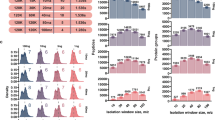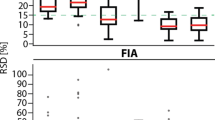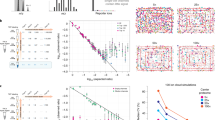Abstract
Metabolomics has emerged as a powerful tool for addressing biological questions. Liquid chromatography coupled with mass spectrometry (LC-MS) is widely used for metabolic characterization, including targeted and untargeted approaches. Despite recent innovations, a crucial aspect of this technique is the sample preparation for accurate data analyses. In this protocol, we present a robust and adaptable workflow for metabolic analyses of mammalian cells from adherent cell cultures, which is particularly suited for qualitative and quantitative central metabolite characterization by LC-MS. Each sample consists of 600,000 mammalian cells grown on cover glasses, allowing for fast and complete transfer of the cells for metabolite extraction or medium exchange, e.g., for labeling experiments. The sampling procedure includes a fast and efficient washing step in liquid flow in water, which reduces cross-contamination and matrix effects while minimizing perturbation of the metabolic steady state of the cells; it is followed by quenching cell metabolism. The latter is achieved by using a −20 °C cold methanol acetonitrile mixture acidified with formic acid, followed by freeze drying, metabolite extraction and LC-MS. The protocol requires 2 s for cell sampling until quenching, and the entire protocol takes a total of 1.5 h per sample when the provided nanoscale LC-MS method is applied.
This is a preview of subscription content, access via your institution
Access options
Subscribe to this journal
Receive 12 print issues and online access
$259.00 per year
only $21.58 per issue
Buy this article
- Purchase on Springer Link
- Instant access to full article PDF
Prices may be subject to local taxes which are calculated during checkout





Similar content being viewed by others
References
Leon, Z., Garcia-Canaveras, J.C., Donato, M.T. & Lahoz, A. Mammalian cell metabolomics: experimental design and sample preparation. Electrophoresis 34, 2762–2775 (2013).
Bennett, B.D., Yuan, J., Kimball, E.H. & Rabinowitz, J.D. Absolute quantitation of intracellular metabolite concentrations by an isotope ratio-based approach. Nat. Protoc. 3, 1299–1311 (2008).
Bolten, C.J., Kiefer, P., Letisse, F., Portais, J.C. & Wittmann, C. Sampling for metabolome analysis of microorganisms. Anal. Chem. 79, 3843–3849 (2007).
Beloueche-Babari, M. et al. Identification of magnetic resonance detectable metabolic changes associated with inhibition of phosphoinositide 3-kinase signaling in human breast cancer cells. Mol. Cancer Ther. 5, 187–196 (2006).
Panopoulos, A.D. et al. The metabolome of induced pluripotent stem cells reveals metabolic changes occurring in somatic cell reprogramming. Cell Res. 22, 168–177 (2012).
Yuan, J., Bennett, B.D. & Rabinowitz, J.D. Kinetic flux profiling for quantitation of cellular metabolic fluxes. Nat. Protoc. 3, 1328–1340 (2008).
Guillaume-Gentil, O., Zambelli, T. & Vorholt, J.A. Isolation of single mammalian cells from adherent cultures by fluidic force microscopy. Lab Chip 14, 402–414 (2014).
Potthoff, E. et al. Toward a rational design of surface textures promoting endothelialization. Nano Lett. 14, 1069–1079 (2014).
Kiefer, P., Delmotte, N. & Vorholt, J.A. Nanoscale ion-pair reversed-phase HPLC-MS for sensitive metabolome analysis. Anal. Chem. 83, 850–855 (2011).
Kentner, D. et al. Shigella reroutes host cell central metabolism to obtain high-flux nutrient supply for vigorous intracellular growth. Proc. Natl. Acad. Sci. USA 111, 9929–9934 (2014).
Rabinowitz, J.D. & Kimball, E. Acidic acetonitrile for cellular metabolome extraction from Escherichia coli. Anal. Chem. 79, 6167–6173 (2007).
Kiefer, P., Nicolas, C., Letisse, F. & Portais, J.C. Determination of carbon labeling distribution of intracellular metabolites from single fragment ions by ion chromatography–tandem mass spectrometry. Anal. Biochem. 360, 182–188 (2007).
Kiefer, P., Portais, J.C. & Vorholt, J.A. Quantitative metabolome analysis using liquid chromatography–high-resolution mass spectrometry. Anal. Biochem. 382, 94–100 (2008).
Michalski, A. et al. Mass spectrometry-based proteomics using Q Exactive, a high-performance benchtop quadrupole Orbitrap mass spectrometer. Mol. Cell. Proteomics 10, M111.011015 (2011).
Forcisi, S. et al. Liquid chromatography–mass spectrometry in metabolomics research: mass analyzers in ultra-high-pressure liquid chromatography coupling. J. Chromatogr. A 1292, 51–65 (2013).
Buescher, J.M., Moco, S., Sauer, U. & Zamboni, N. Ultrahigh performance liquid chromatography–tandem mass spectrometry method for fast and robust quantification of anionic and aromatic metabolites. Anal. Chem. 82, 4403–4412 (2010).
Lu, W., Kimball, E. & Rabinowitz, J.D. A high-performance liquid chromatography–tandem mass spectrometry method for quantitation of nitrogen-containing intracellular metabolites. J. Am. Soc. Mass. Spectrom. 17, 37–50 (2006).
Lu, W. et al. Metabolomic analysis via reversed-phase ion-pairing liquid chromatography coupled to a stand-alone Orbitrap mass spectrometer. Anal. Chem. 82, 3212–3221 (2010).
Atkinson, D.E. The energy charge of the adenylate pool as a regulatory parameter. Interaction with feedback modifiers. Biochemistry 7, 4030–4034 (1968).
Acknowledgements
Funding was provided by SystemsX, The Swiss Initiative in Systems Biology (Research, Technology and Development (RTD) project 'BattleX').
Author information
Authors and Affiliations
Contributions
All authors developed the protocol and discussed its applications. G.M., N.D., P.C. and D.K. acquired the data for setup experiments. G.M. and N.D. analyzed the data. P.K. wrote the manuscript with contributions from G.M., P.C. and D.K. All authors commented on the manuscript and approved it.
Corresponding author
Ethics declarations
Competing interests
The authors declare no competing financial interests.
Supplementary information
Supplementary Data
Supplementary data set. (PDF 36968 kb)
Rights and permissions
About this article
Cite this article
Martano, G., Delmotte, N., Kiefer, P. et al. Fast sampling method for mammalian cell metabolic analyses using liquid chromatography–mass spectrometry. Nat Protoc 10, 1–11 (2015). https://doi.org/10.1038/nprot.2014.198
Published:
Issue Date:
DOI: https://doi.org/10.1038/nprot.2014.198
This article is cited by
-
Characterizing the effects of hypoxia on the metabolic profiles of mesenchymal stromal cells derived from three tissue sources using chemical isotope labeling liquid chromatography-mass spectrometry
Cell and Tissue Research (2020)
-
A comprehensive protocol for multiplatform metabolomics analysis in patient-derived skin fibroblasts
Metabolomics (2019)
-
In vitro assessment of hepatotoxicity by metabolomics: a review
Archives of Toxicology (2018)
-
Promises and pitfalls of untargeted metabolomics
Journal of Inherited Metabolic Disease (2018)
-
Sex-specific eNOS activity and function in human endothelial cells
Scientific Reports (2017)
Comments
By submitting a comment you agree to abide by our Terms and Community Guidelines. If you find something abusive or that does not comply with our terms or guidelines please flag it as inappropriate.



